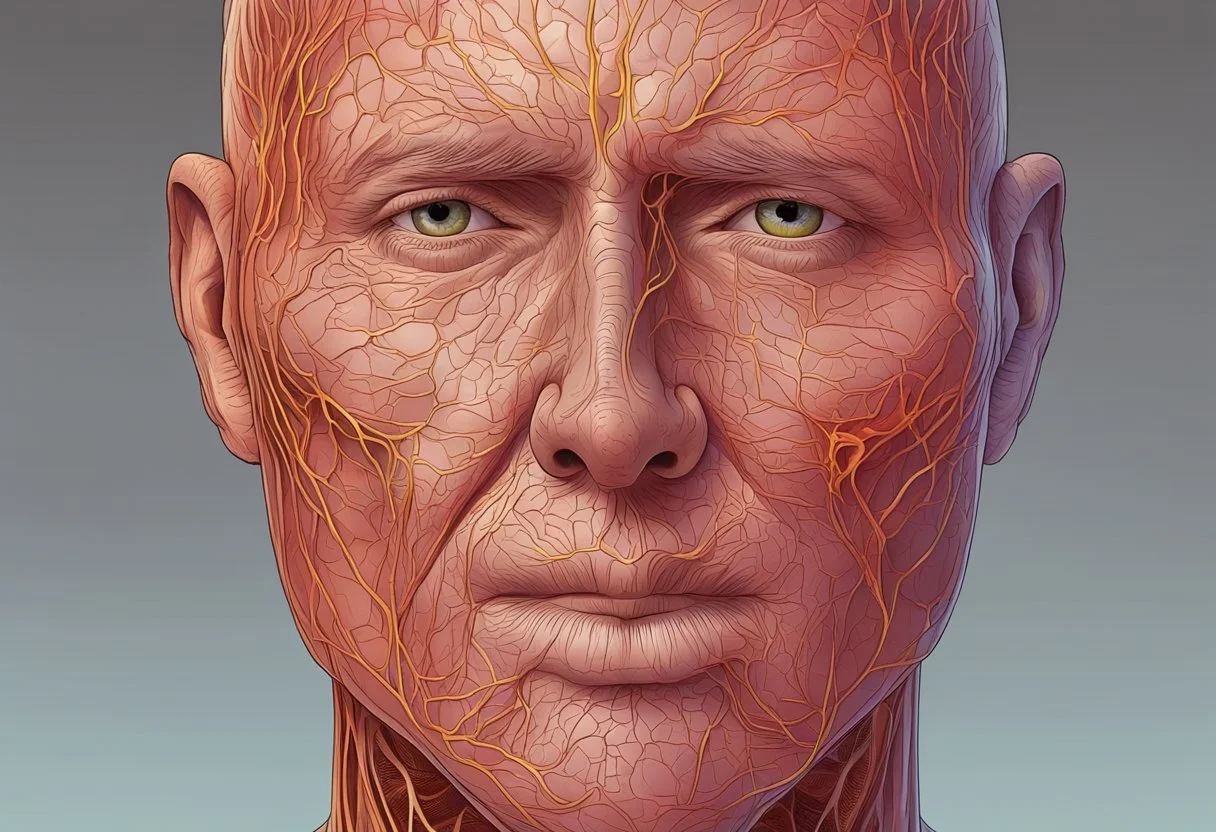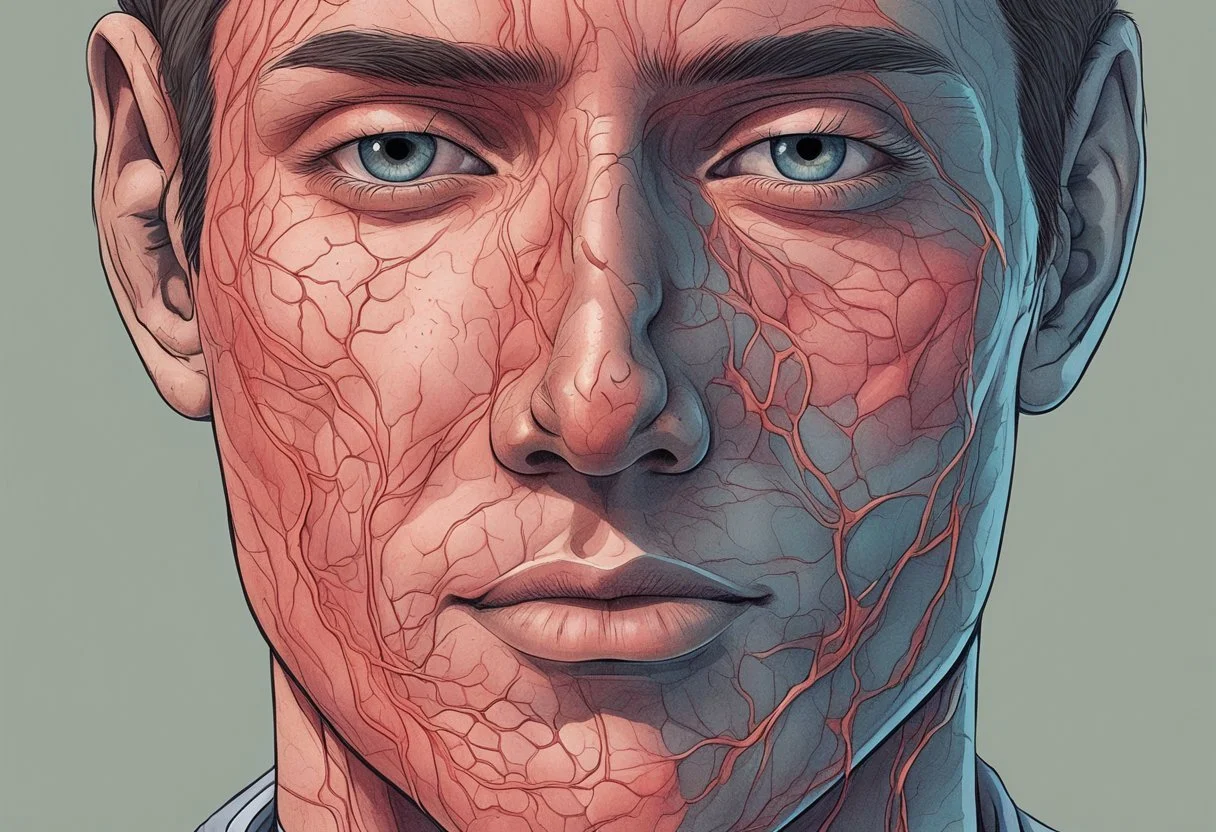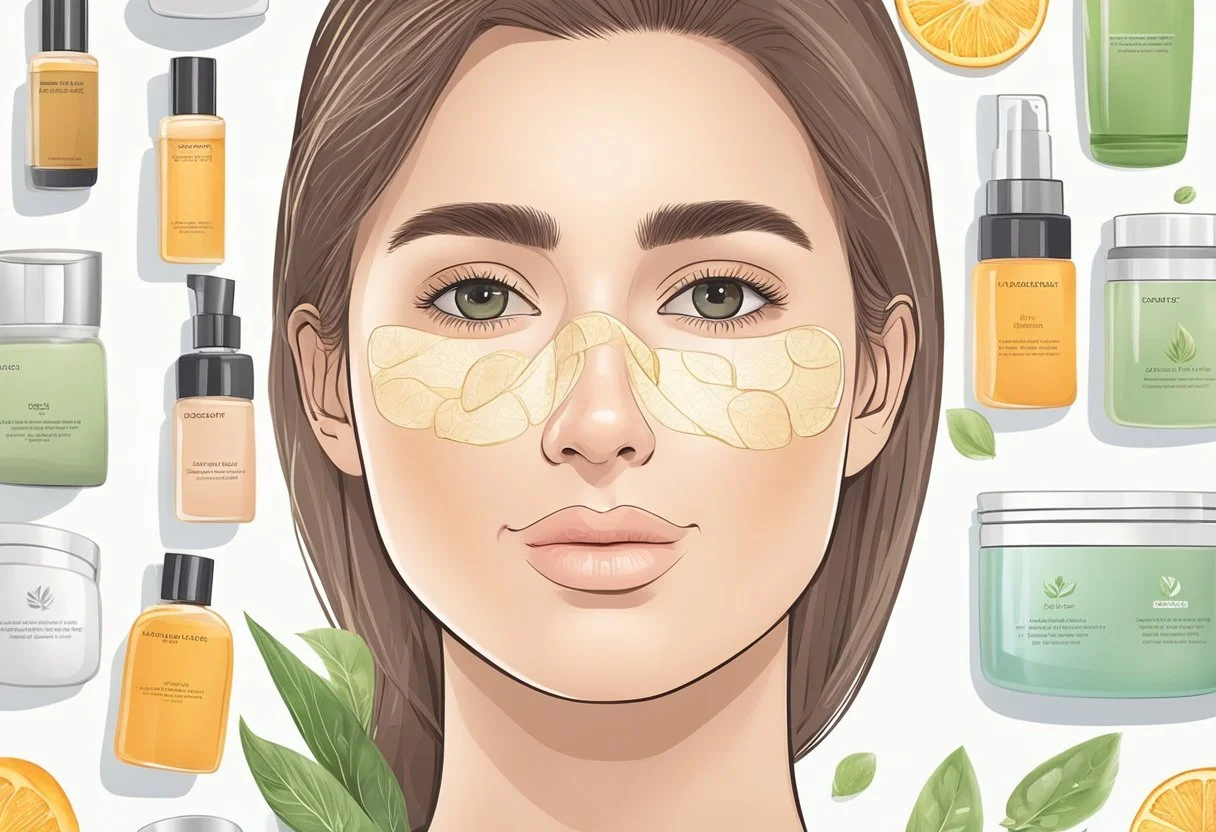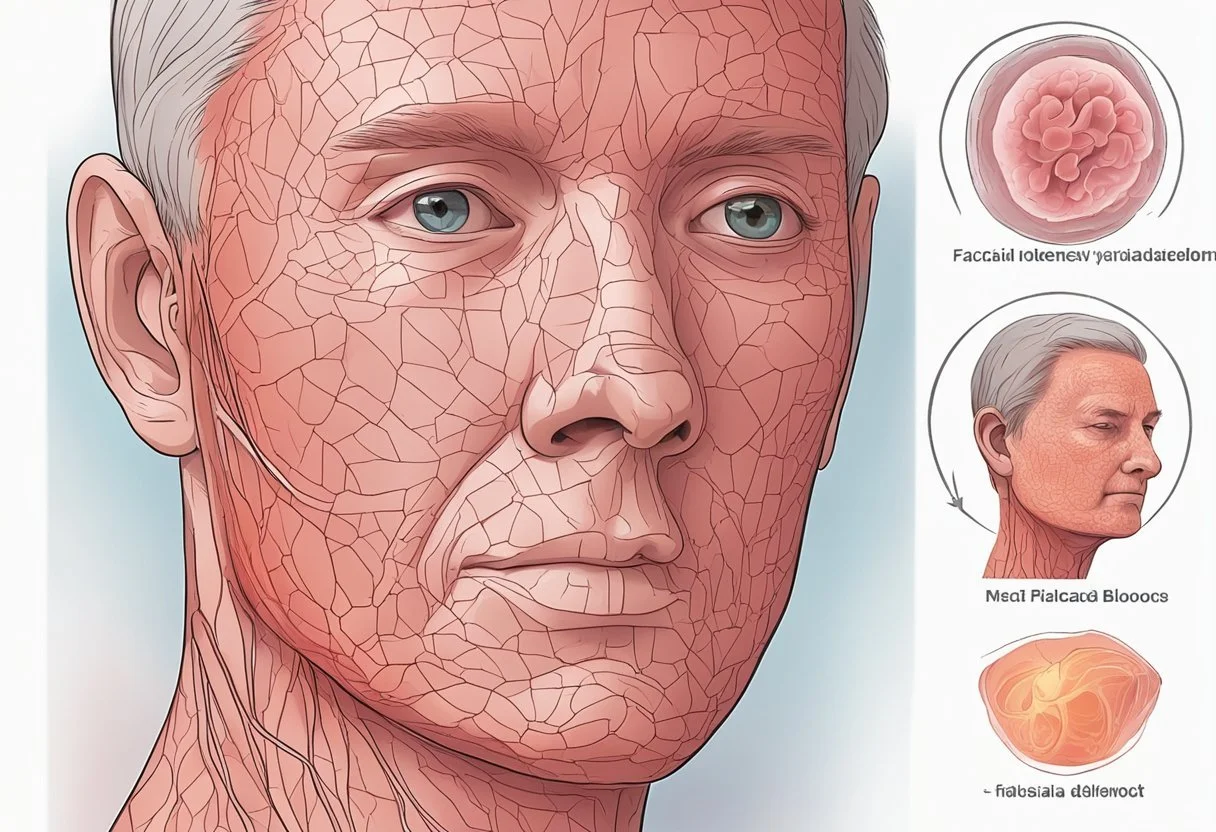Rosacea
Symptoms, Causes, and Home Remedies
Discover > Health Conditions > Rosacea
Rosacea is a chronic skin condition that primarily affects the face, causing redness, visible blood vessels, and sometimes even acne-like bumps. This inflammatory condition often appears in individuals between the ages of 30 and 60 and has a higher prevalence in those with fair skin. As rosacea can impact an individual's self-esteem and overall quality of life, it is essential to understand its symptoms, causes, and potential home remedies to better manage the condition.
The symptoms of rosacea may vary from one individual to another, but typically include persistent facial redness, swollen blood vessels on the surface of the skin, and small red bumps or pustules. These symptoms can come and go, often triggered by certain factors such as sunlight, heat, stress, or specific skincare products. Knowing one's triggers and avoiding them as much as possible can significantly help reduce flare-ups.
While the exact cause of rosacea remains unknown, experts believe it may be due to a combination of genetic and environmental factors. There is currently no cure for rosacea, but various home remedies can help manage and alleviate symptoms. These remedies may include lifestyle changes, gentle skincare routines, and natural anti-inflammatory treatments. However, it is always essential to consult a dermatologist for personalized recommendations and treatment plans.
Understanding Rosacea
What Is Rosacea?
Rosacea is a common chronic skin condition that primarily affects the face. It is characterized by redness, flushing, bumps, and visible blood vessels. This condition can affect anyone, but it is most commonly seen in people with fair skin and those over the age of 30.
Symptoms of Rosacea
Some common symptoms of rosacea include:
Persistent redness, often resembling a blush or sunburn
Flushing, or episodes of increased redness and warmth in the face
Small bumps and pimples, sometimes filled with pus (papules and pustules)
Visible blood vessels on the surface of the skin
In some cases, a person may also experience ocular rosacea, which affects the eyes and can lead to symptoms such as dryness, irritation, and swelling.
Types of Rosacea
There are three main types of rosacea:
Erythematotelangiectatic rosacea (ETR): This type is characterized by redness and visible blood vessels. It is often accompanied by flushing and may worsen after exposure to certain triggers, such as heat or alcohol.
Papulopustular rosacea: This subtype presents with persistent redness and acne-like bumps (papules and pustules). It may resemble acne, but unlike acne, it does not involve blackheads or whiteheads.
Ocular rosacea: As mentioned earlier, ocular rosacea affects the eyes and can cause a range of symptoms, including dryness, irritation, and red, swollen eyelids.
Managing rosacea often involves identifying and avoiding triggers, as well as using gentle skincare products and incorporating home remedies such as cold compresses and green tea. In some cases, a dermatologist may recommend prescription treatments to help manage symptoms.
Factors Contributing to Rosacea
Genetic and Environmental Causes
Rosacea is a chronic skin condition that primarily affects fair-skinned individuals, usually between the ages of 30 and 50. There is a genetic component to rosacea, as people with a family history of the condition are more likely to develop it. Environmental factors, such as sun exposure, are also believed to play a role in the development of rosacea. Prolonged exposure to the sun can cause skin damage and inflammation, increasing the risk of rosacea flare-ups.
Common Rosacea Triggers
There are several known triggers that can exacerbate rosacea symptoms, although they may vary from person to person. Some common triggers include:
Stress: Stress is known to release inflammatory chemicals in the body, which can worsen rosacea symptoms for some individuals.
Sun exposure: Ultraviolet (UV) radiation from the sun can cause inflammatory skin damage, making it essential for individuals with rosacea to wear sun protection and limit their time in the sun.
Alcohol: Alcohol acts as a vasodilator, causing blood vessels to dilate and potentially exacerbating rosacea symptoms.
Spicy foods: (What wine goes well with spicy food?) Some people with rosacea may experience flare-ups after consuming spicy foods, as these foods can also cause blood vessels to dilate.
Temperature: Sudden changes in temperature, such as going from a warm room to a cold outdoor environment, can trigger rosacea in some individuals.
Exercise: Strenuous exercise can increase blood flow to the skin, causing facial flushing and potentially triggering rosacea for some individuals.
While these factors can contribute to the development or worsening of rosacea symptoms, it is important for individuals with the condition to track their own personal triggers and make necessary lifestyle adjustments to help manage their symptoms effectively.
Identifying Rosacea
Visual Examination
During a visual examination, a dermatologist will assess the patient's skin for common rosacea symptoms, specifically focusing on the cheeks, nose, chin, and forehead. Some key signs to look for include:
Redness: Persistent redness on the central areas of the face, such as cheeks and nose.
Visible blood vessels: The appearance of small, widened blood vessels on the surface of the skin.
Swelling: Inflammation and swelling of the affected areas.
Eye symptoms: Rosacea can also affect the eyes, causing redness, irritation, and a gritty sensation.
It is essential for the dermatologist to thoroughly examine the patient's skin to make an accurate diagnosis.
Differential Diagnosis
Since rosacea shares symptoms with various other skin conditions, a dermatologist will need to perform a differential diagnosis to rule out the following possibilities:
Acne: Rosacea can often be confused with acne, as both conditions involve pimples and redness. However, acne typically has blackheads and whiteheads, while rosacea does not.
Seborrheic dermatitis: This condition causes red, scaly patches on the face, particularly around the nose, eyebrows, and the skin behind the ears. Seborrheic dermatitis can coexist with rosacea, making a diagnosis more challenging.
Lupus erythematosus: Lupus is an autoimmune disease that can also cause redness and butterfly-shaped rash on the cheeks and nose. However, lupus often comes with additional symptoms, such as joint pain and fatigue.
To determine the cause of the skin condition, the dermatologist may ask the patient about their symptoms, personal and family medical history, and any triggering factors, such as sun exposure or spicy foods. Based on these findings, the dermatologist will provide a diagnosis and recommend suitable home remedies and treatments.
Treating Rosacea
Rosacea is a chronic skin condition characterized by redness, swelling, and visible blood vessels on the face. While there is no cure, rosacea symptoms can be managed with a combination of medical treatments, lifestyle and home remedies, and proper skin care.
Medical Treatments
Several medical treatments are available for managing rosacea, depending on the severity and type of symptoms. Some commonly prescribed treatments include:
Anti-inflammatory creams: Topical treatments, such as metronidazole or azelaic acid, help to reduce inflammation and redness.
Antibiotics: Oral or topical antibiotics, like doxycycline or erythromycin, can help control rosacea symptoms by reducing inflammation.
Sulfur-based treatments: Sulfur-containing creams and washes can help manage rosacea by reducing redness and inflammation.
It is essential to consult a dermatologist for the appropriate medication suited to individual needs and to follow their guidance for usage.
Lifestyle and Home Remedies
In addition to medical treatments, implementing some lifestyle changes and home remedies can help manage rosacea by reducing triggers. Some effective strategies include:
Sun protection: Wear a broad-spectrum sunscreen with a minimum SPF 30 daily, seek shade, and avoid direct sunlight during peak hours.
Stress management: Identify and manage stress through relaxation techniques, regular exercise, and a balanced diet.
Avoid irritants: Steer clear of skincare products containing alcohol, fragrance, or other irritants that may exacerbate redness and swelling.
Monitor dietary triggers: Certain foods and beverages, like spicy foods, alcohol, and hot drinks, can trigger rosacea flare-ups. Maintain a food diary to identify and avoid potential triggers.
Skin Care Recommendations
Following a gentle and consistent skincare routine is crucial for managing rosacea. Here are some recommendations for effective skin care:
Cleanser: Use a gentle, soap-free cleanser that won't strip the skin or cause irritation. Look for products designed specifically for sensitive skin or rosacea.
Moisturizer: Choose a fragrance-free, hypoallergenic moisturizer to keep the skin hydrated and protected. Apply it daily, especially after cleansing.
Sunscreen: As mentioned in lifestyle and home remedies, always wear broad-spectrum sunscreen with a minimum SPF 30 to protect the skin from further damage.
By combining medical treatments, lifestyle, and home remedies with the proper skin care routine, individuals with rosacea can effectively manage their symptoms and maintain healthy, comfortable skin.
Complications of Rosacea
Physical Effects
Rosacea can lead to various physical complications, particularly when left untreated. One of the most noticeable complications is rhinophyma, which is caused by the thickening of the skin on the nose. This condition is more common in men and can result in a bulbous and enlarged appearance. Prolonged inflammation, demodex presence, and bacteria can contribute to the development of rhinophyma.
In addition to rhinophyma, ocular rosacea is another common complication. It manifests as eye problems such as dryness, redness, itching, and swelling of the eyelids. In severe cases, ocular rosacea can lead to inflammation of the cornea and vision issues. It is crucial for individuals experiencing eye problems related to rosacea to consult a healthcare professional for proper diagnosis and treatment.
Psychological Impact
The visible symptoms of rosacea can have a significant effect on an individual's self-esteem and mental well-being. The psychological impact of rosacea can lead to:
Social withdrawal
Low self-confidence
It is essential for individuals with rosacea to be aware that support and guidance are available to help cope with the emotional consequences of this skin condition. Mental health professionals and support groups can provide valuable resources for managing the psychological impact of rosacea.
Preventing Rosacea Flare-Ups
One of the most effective ways to manage rosacea, a common skin condition that affects the face, is to prevent flare-ups. Identifying and avoiding triggers are crucial steps to minimize the occurrence of symptoms. The following paragraphs will discuss some common triggers and how to deal with them through effective skincare practices.
Triggers Knowing the triggers that cause rosacea flare-ups is the starting point for preventing them. Some common triggers include:
Sun exposure
Alcohol consumption
Stress
Physical exertion
Extreme temperatures
Spicy foods
It's essential to monitor which factors cause flare-ups and adjust your lifestyle accordingly.
Skin Care - Proper skin care can also contribute to preventing rosacea flare-ups. Here are some tips for managing the skin condition:
Choose gentle skincare products: Opt for mild, fragrance-free cleansers and moisturizers designed for sensitive skin to avoid further irritation.
Avoid rubbing or touching the face: This can irritate the skin and worsen rosacea symptoms.
Apply sun protection: Use a broad-spectrum sunscreen with at least SPF 30, and wear wide-brimmed hats and sunglasses to protect your face from the sun.
Incorporating these skin care practices can help maintain the health of your skin while minimizing the appearance of rosacea symptoms.
Lifestyle Modifications Managing your lifestyle can enhance treatment options and further prevent rosacea flare-ups. Consider the following recommendations:
Avoid alcohol: Since alcohol is a common trigger for rosacea, reducing its consumption can help prevent flare-ups.
Manage stress: Implementing stress management techniques, such as yoga, meditation, and exercise, can help reduce the likelihood of flare-ups.
Stay cool: Opt for cooler environments and avoid exposure to extreme temperatures, such as saunas or hot showers, as these can aggravate your skin condition.
Adhering to these lifestyle modifications combined with proper skin care practices and an awareness of your triggers can significantly lessen the frequency and severity of rosacea flare-ups.
When to See a Doctor
Rosacea is a chronic skin condition that presents with a variety of symptoms, including redness, swelling, and visible blood vessels on the face. While it is possible to manage mild rosacea with home remedies and self-care, there are instances when one must seek professional help. This section will discuss the situations in which it's advised to consult a doctor.
Persistent or Worsening Symptoms: If the symptoms of rosacea continue to persist or worsen despite trying home remedies and over-the-counter treatments, it's time to consult a dermatologist. A doctor can accurately diagnose the condition and recommend appropriate medical treatment.
Skin Thickening: One of the complications of rosacea is skin thickening, which may lead to a condition known as rhinophyma. Rhinophyma mostly affects the nose and results in bulbous, enlarged appearance. If an individual observes thickening of the skin, it is crucial to visit a dermatologist for proper evaluation and treatment.
Eye Irritation: Rosacea can cause eye-related problems, such as dryness, redness, and discomfort, which are collectively known as ocular rosacea. If eye symptoms become severe or persistent, promptly seek advice from a doctor or an ophthalmologist as untreated ocular rosacea may lead to complications affecting vision.
Ineffectiveness of Home Remedies: It's essential to be patient when trying out home remedies, as some may take a few weeks to show improvements. However, if home remedies fail to improve the symptoms within a reasonable time frame, consulting a doctor is advised. A dermatologist may prescribe medications that can target the specific cause of rosacea, such as antibiotics or topical creams containing azelaic acid.
In conclusion, although rosacea can often be managed with self-care and home remedies, it is vital to monitor symptoms and be aware of when to seek medical attention. If symptoms persist or worsen, skin thickening occurs, eye irritation becomes severe, or home remedies are ineffective, a doctor's evaluation and treatment are necessary to prevent complications and improve the skin's overall health.
#skin redness #enlarged blood vessels #pus filled bumps #rosacea diagnosed #small blood vessels #thickened skin #excess tissue #treat rosacea






